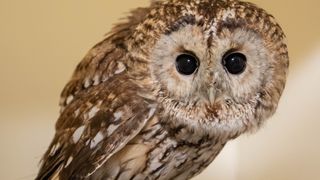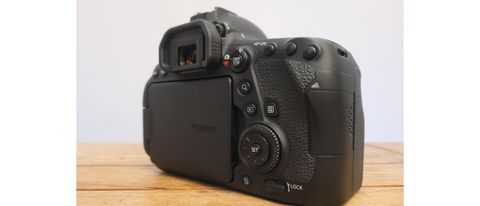Space Verdict
This is a great choice if you're looking for a reliable all-rounder and a good introduction to full-frame. It's good at most things, great for stationary or slow-moving subjects such as landscapes or portraits, but not so great for capturing fast action. It sits at a reasonable price point for its capabilities although other full-frame cameras with similar or higher specs are available for similar cost.
Pros
- +
Excellent connectivity capabilities
- +
Great introduction to full-frame
- +
Good backup option for pros
Cons
- -
Doesn't break any exciting new ground
- -
Doesn't shoot in 4k
- -
Autofocus is outshined by competitors
Why you can trust Space.com
The original Canon EOS 6D saw the birth of a new breed of cameras, one that introduced beginner, enthusiast, and amateur photographers to the idea of an accessible full-frame system. For those of us who balk at the idea of spending thousands of dollars on pro or semi-pro systems, the 6D offered an affordable alternative and one that drew positive recognition from the industry and the photography community.
Type: DSLR
Sensor: 26.2MP
Lens mount: Canon EF
ISO range: 100-40000
Viewfinder: Optical viewfinder 45-point autofocus
Video capability: 1080p
Weight: 1.6 lbs (body only)
Size: 5.7" x 4.4" x 2.9" (body only)
Memory card type: SD-card (one slot)
The Canon EOS 6D Mk2 looks to update the original 6D with a far more modern specification list. Although the Mk2 is over five years old now, it's still a relevant and worthwhile consideration for many of us looking to get more serious about photography. Although, as we'll discuss, there are some compromises to be made, the price alone makes the 6D Mk2 an appealing prospect. You expect to pay around $1000 less than a similar full-frame camera from the 'next level up', such as the Canon 5D Mk IV.
As time marches on, the Canon 6D Mk2 finds itself sitting in a growingly competitive market, so in this review, we'll see if it still matches up to modern-day demands by reviewing its design, functionality, and image-making abilities. It still sits among our best DSLR cameras and best cameras for astrophotography, especially as the price is relatively competitive.
Canon EOS 6D Mk2 review: Design
- Body feels a little clunky and plasticky
- Conventional Canon layout will suit prior users of the manufacturer's products
- Vari-angle touch screen a nice addition

First things first, out of the box, the Canon 6D Mk2 is noticeably heavier and bulkier if you're used to a compact or crop-sensor body. Although it is weatherproofed, we thought the slightly plastic feel of the body itself was disappointing, but like many Canon products we were pleased to see well-rounded edges, a good hand grip, and nicely rounded buttons. Overall, ergonomically the camera is easy to use, fits into the hand nicely, and provides easy access to most controls.
Canon's 6D Mk2 looks, like any other modern Canon DSLR. This is great if you're used to being a Canon user in terms of familiarity, but there's also enough on-button instruction and symbols to pick up what each does even if you're completely new to Canon.
At the rear of the camera, there are buttons to change the autofocus mode, access the camera's menus and settings, and switch it between still and movie modes. As with Canon's other full-frame offerings, there's a dial at the back, which can be controlled using the outer thumbwheel or more conventionally by selecting left, right, up and down on the direction buttons. It takes a little getting used to, but in shooting mode it comes into its own and allows far greater control of multiple settings at once. There's a start/stop button for movie recording and a 'Q' menu button that allows quick access to important shooting settings.
The key element to the rear of the camera is the vari-angled touchscreen, which we found worked well and allowed us to compose our images using more acute angles. It's a little dull when exposed to bright sunlight, but overall the touch responsiveness is excellent and allows a good degree of manual control.
At the top of the camera, there's a dedicated screen so you can see what the camera is set to at a glance, as well as a mode control selector on the top left. There's a little button at the top of the selector which needs to be depressed to change the camera's mode, which means it doesn't slip out of your chosen setting accidentally; but one to mention as it caught us out a couple of times, the selector won't move without the button being depressed. Overall, whilst it is nothing revolutionary, the Canon 6D Mk2 design and handling are pleasing and will suit most entry-level full-frame photographers.

Canon EOS 6D Mk2 review: Functionality
- Speed of use and operation a big improvement on the 6D Mk1
- Noticeably lighter than 7D and 5D products
- Live view works well
- Slightly fiddly rear dial and controller

Using the Canon 6D Mk2 is much like using any other Canon product, and comparisons to the crop-sensor 80D can't be avoided, as they have almost exactly the same rear panel and feel in the hand.
Kit lens: EF 24-105mm f/3.5-5.6 IS STM Lens
Best wide lens: Canon EF 11-24mm f/4L USM
Best zoom lens: Canon EF 70-200mm f/2.8L IS III USM
Spare battery type: LP-E6NH
Memory card: SD card
One thing we did notice and enjoy was the speed of operation. Even in live mode, everything turns on, boots up and is ready to go in an instant, which greatly assists in getting those momentary or easy-to-miss shots. As you'd expect on a full-frame system, the large viewfinder makes it easy to compose shots. Although it does feel bulky, the weight has been nicely trimmed compared to the 5D and it feels like an easy unit to deal with. We tested the system with Canon's 24-105mm lens, which does add considerable weight, but users of 50mm or smaller prime lenses will certainly notice the weight reduction.
Dual Pixel technology means that the Live View works well in most conditions, although we did find it a little hard to see in direct sunlight. It feels good to use and is very responsive though, which twinned with its vari-angle articulating ability means shooting from the hip or at strange angles is perfectly doable.
Although we thought the dial at the rear of the camera was easy to use, the inner directional buttons are difficult and sometimes fiddly and we thought Canon would have been best to do without them and opt for a simpler system like the joystick on its 5D. This is especially relevant if you want to manually adjust focus through the viewfinder, for example. That being said, we thought there was an emerging theme here, Canon has to find a way of differentiating the 6D Mk2 as being the 'lower spec' entry-level DSLR.
The Canon EOS 6D Mk2 can be used alongside Canon's Camera Connect app over the built in Wi-Fi, Bluetooth or NFC. We tried it using NFC and it worked seamlessly. We set the camera up by a bird feeding table and were able to control all of the camera's settings using a smartphone, allowing us to take natural shots of blackbirds coming down for their mealworms without disturbing or scaring them. We did have to keep the door slightly ajar so we didn't lose signal when using NFC but we didn't encounter any issues when using the camera's Wi-Fi.
Canon EOS 6D Mk2 review: Performance
- Lacking the dynamic range needed for pro photographers to feel confident
- Good color reproduction in out-the-box JPG shots
- Full-frame means low light performance is good
- Impressively quiet shutter
- Hard to recommend for filmmakers

When we got down to business, we liked how the Canon 6D Mk2 performed. While it doesn't do anything particularly special that's worth writing home about, we were impressed with its ability to keep up with the demands of the modern shooter. Five years on from its release, the autofocus is perhaps lacking a little but in most other respects, it performs well.
The above photo of a Tawny Owl was taken handheld, indoors at a rehabilitation center where the lighting wasn't favorable. You can see the clarity and detail that is possible in challenging conditions without any post-production. This makes it a very enjoyable camera for beginners and intermediates alike.
When used with a lens with in-built 5-axis image stabilization, it's possible to shoot comfortably, getting crisp images without using a tripod (aside from astro of course).
With no settings altered, straight to auto mode, the JPGs at the highest resolution were pleasing when it comes to color rendition and accuracy, although we found that like many other Canon systems they had a slightly over-processed feel to them, and appear a bit on the sharp side. The camera worked very well in areas of subtle contrast, but out in the sunshine was where performance cracks did start to appear.

Much has been made of Canon's decision not to put the latest sensor (at the time) into the 6D Mk2, as used on the 5D Mk4 and EOS 80D. Again, a differentiation of price-point must have been the primary concern here. In areas of high contrast, at lower ISO settings, there's a noticeable diminishing of dynamic range (the ratio difference between the brightest and darkest tones within an image) which means that boosted photos can start to appear grainy and noisy, especially where the lower tones have been increased. Because of this, we'd suggest that experienced photographers look elsewhere. If you know what you're doing in post-processing, you may find the lack of range frustrating.
That being said, with what the camera is setting out to do, how much did we worry about this? The answer is not loads, to be honest, as in most other respects we enjoyed what the camera had to provide, and we expect most other enthusiasts or amateur photographers would do too. For newcomers to the full-frame world, the possibilities it opens up are exciting and go far beyond worrying about dynamic range. With regards to the wider angled, lower-light astrophotography sphere, low light performance is good and the quiet shutter and subtle operation would suit night photography, except for shots where there is fast action.
Another recent test environment for this camera was an indoor kickboxing class, a challenging test environment given it was a dimly lit room with some narrow horizontal windows which let lots of light into very focused areas of our frame.
We found that using the articulating screen to compose shots felt less intrusive than looking through the viewfinder at the subject which in turn meant they didn't change their behavior to 'perform' for us. The same can be said for the quietness of the shutter.
One word on the autofocus system is that we found it to be perfectly dependable in stable environments, and it'd be fine for low-light, still life photography. It did struggle with moving subjects and the subject tracking is pretty average (even more so in Live View). The 6.5 FPS and tracking AF felt frustratingly slow, it was a struggle to get the unpredictable and erratic movements captured in focus. Something like the Canon 7D MK2 would have performed much better here. If you're a budding sports or events photographer, especially indoor sports, based on our findings, we'd recommend looking elsewhere.

The battery life is excellent, especially for a full-frame DSLR. It's CIPA rated at 1200 shots from a full charge. After we'd taken 546 shots, mostly using the 'live view' mode (thus drawing more power for the screen) we had only used 33% of the battery, which is better than what is expected based on the rating. This would benefit travel photographers who want to travel as light as possible day-to-day as there shouldn't be a need to carry spare batteries.
Should you buy the Canon EOS 6D Mk2?
With its increased megapixel count, faster operation, and generally better handling, the Canon EOS 6D Mk2 is a vast improvement over the aging original 6D and has many things to recommend it. The image quality is excellent and in the right hands, it is a very capable machine.
Although it's not the most exciting camera development and there is still room for improvement, we found it hard not to enjoy using it despite its shortcomings in terms of autofocus and lack of dynamic range. If we put those to one side for a moment, for people getting into the full-frame world for the first time, it's an exciting prospect to be faced with a far more advanced and pleasing style of image-making, especially for landscape and portrait photographers.
In the years since the 6D Mk2 was released, there have been improvements in the entry-level full-frame market, so it's worth mentioning that you may want to do some research. That's not to say the 6D Mk2 is a bad camera, it's far from it, but it would pay to do some testing of other systems to ensure that with this one you're getting the most from your hard-earned cash.
If this product isn't for you
If you need a camera that can capture high speed movement in a similar price range or cheaper, you might want to consider the Canon R6 which has a greater ISO range and has a much quicker continuous shooting speed of 20FPS versus the 6.5 FPS we have here.
Alternatively, you could consider the Canon EOS RP which is Canon's cheapest full-frame camera, and great for mirrorless fans.
The Sony A7 III is an affordable, remarkable camera that shoots at 10FPS and boasts in-body stabilization too. We'd be happy to recommend this to movie makers as well, unlike the 6D Mk2.
If your focus is astrophotography, consider the Nikon D850. It is one of the best DSLR's money can buy and has excellent low light autofocus and high ISO noise handling capacity.
The Pentax K1 MKII is a bit of a different entity, and Pentax's only full-frame system, but although expensive it arguably outshines the Canon EOS 6D Mk2 on paper.
Join our Space Forums to keep talking space on the latest missions, night sky and more! And if you have a news tip, correction or comment, let us know at: community@space.com.
Jacob Little is a photographer, writer and communications professional based in Bristol and Cornwall. His main inspirations come from outdoor adventure, travel, rural living and wild ways and crafts. Passionate about weaving the core principles of storytelling into his images, he approaches brand and copywriting work in much the same way. Conveying a compelling narrative is one of the main drivers behind much of his work.
- Tantse WalterContributing Writer

